WARNING: This page has not been updated since 2005. Some of this information may be very out of date. It will be updated shortly.
Know your aircraft types
Airbus
Airbus A300
Airbus' first aircraft, the A300B, was launched at the 1969 Paris air show.
It was the first widebody twinjet and could carry 226 passengers in a
comfortable two-class lay-out. A stretched 250 seat version, the A300B2,
requested by launch customer Air France, went into full scale production.
By 1974, the A300 had been certified on budget and ahead of schedule - a
major first for European companies at the time. By the end of 1975, Airbus
had 10 per cent of the market and a total of 55 aircraft on order. The
company then went through a dark period, during which it failed to secure
any new orders. Finally, US airline Eastern Airlines decided to lease four
A300B4s.
This was a turning point, and from then on, Airbus never looked back. Within
two years, Airbus had 133 firm orders and market share had risen to 26 per
cent by value. By the end of 1979, Airbus had 256 orders from 32 customers
and 81 aircraft in service with 14 operators.
Airbus A320
 Airbus A320 Tunisair at London Heathrow
Airbus A320 Tunisair at London Heathrow
|
The A320, launched in 1984, was the first all-new design in its category in
30 years. Incorporating new technologies, the aircraft provided better
operating efficiency, better performance and - above all - greater passenger
comfort thanks to a wider fuselage cross-section. It was the first
commercial aircraft to feature 'fly-by-wire' controls and side sticks.
It
set the standard for all subsequent Airbus cockpits and indeed for the
industry as a whole. The introduction of fly-by-wire also enabled Airbus to
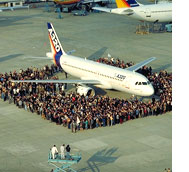 develop a family of aircraft sharing the same cockpit and the same flight
handling characteristics. Airbus Industrie's experience in composite
materials led to the introduction of an all-carbon fiber tail on the A320 --
which has been followed by Airbus Industrie on all subsequent aircraft.
develop a family of aircraft sharing the same cockpit and the same flight
handling characteristics. Airbus Industrie's experience in composite
materials led to the introduction of an all-carbon fiber tail on the A320 --
which has been followed by Airbus Industrie on all subsequent aircraft.
Airbus A321 / A319
The A320 was followed in 1989 by the A321, a lengthened version, seating 185
passengers in a standard three class configuration, and, in 1992, by a
124-seat version - the A319. The single-aisle Family was completed in 1999
with the introduction of the 107-seat A318. The decision to launch the A320
proved a wise one. In spite of the recession of the mid 80s, the aircraft
anticipated market demand for a modern, cost-efficient aircraft to replace
older planes when the economy turned round. The new A320 was quickly chosen
by Air France, British Caledonian, Adria Airways, Air Inter and Cyprus
Airways. Today, it is one of Airbus' best-selling aircraft, popular with
passengers and carriers alike.
A320/340 family
 Airbus A340s LanChillie at Auckland
Airbus A340s LanChillie at Auckland
|
By 1987, it was clear to Airbus that the time was ripe to launch not one, but two larger aircraft in a single programme. The market was ready for a twin engine, medium-haul aircraft as well as a long range, four engine, airliner. The two new airliners share the same airframe, the same wing design and the same popular twin-aisle cross-section as the A300/A310, incorporating the proven fly-by-wire controls of the A320.
The A330 and the A340 are respectively twin engined and four engined variants of the same aircraft. Fuel consumption of the A330 is less, and maintainance is lower, but it requires costly checks and additional equipment if it is to fly for a long time over the ocean (ETOPS).
 Airbus A340s Jamacian and Virgin at LHR
Airbus A340s Jamacian and Virgin at LHR
|
Many passengers prefer the A330/A340 over Boeing's 777 variants. The A330/A340 Family features a four-abreast arrangement in First Class, with each passenger enjoying unimpeded access to an aisle. Business Class features spacious six-abreast seating, affording each passenger an aisle or window seat (except for Qantas, which has "squeezed" in an extra row), while Economy Class passengers are generally seated in a comfortable eight-abreast layout (2+4+2 except on Emirates 3+3+3) with no passenger more than one seat away from an aisle.
Airbus A340
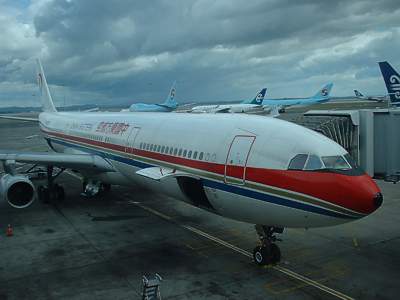 Airbus A340 China Eastern Airlines at Auckland
Airbus A340 China Eastern Airlines at Auckland
|
When the four-engine A340 entered service in 1993, it was the first entirely new,
long-haul aircraft to start commercial operations for more than 20 years.
The A340-200 typically carries 263 passengers in three classes while the larger A340-300 carries 295. The latest version of the A340 extend the range - by extending the aircraft. It is the largest aircraft flying today. The larger of the two additional versions from 2002 is the A340-600, with 380 passengers flying up to 7,650nm. The ultra-long range, 313 seat, A340-500 has a range of up to 8,850nm.
In geographical miles, the absolute longest reach is a 10,184-mile maximum range. That means from London Heathrow Perth, Darwin and Cairns are all are within the plane's range. Sadly, none of those cities is likely to be sufficiently attractive to airlines to launch a single-hop schedule to Australia. And Sydney, choice of arrival point for most British travellers, is 380 tantalising miles beyond the aircraft's reach.
 Airbus A340 British West Indies Airlines LHR
Airbus A340 British West Indies Airlines LHR
|
Since entering service the A340 has joined the fleets of 17 different airlines worlwide and has carried more than nine million passengers. Major operators include Airlanka, Kuwait Airways, Air Canada, Lufthansa, Gulf Air, Cathay Pacific, Singapore Airlines, Virgin Atlantic Airways, Austrian Airlines, Air Mauritius, Turk Hava Yollari, Air France, TAP Air Portugal, Iberia, and Sabena.
Airbus A330
 Airbus A310 Yemen Airways at LHR
Airbus A310 Yemen Airways at LHR
|
The twin-engine A330 which joined the A340 a year later combined some of the lowest operating costs of any aircraft ever designed with maximum flexibility for a wide range of route structures.
The base model is the A330-300, which first entered service in early 1994. It typically seats 335 passengers (295 in 3 classed) and can fly up to 5,600nm. It was joined in 1998 by the A330-200, which offers long range capability of up to 6,650 nm but seats fewer - 253 passengers in three classes.
Airbus A380
In December 2000, Airbus launched the 555-seat A380 superjumbo programme at the top end of the spectrum. This all-new double-decker aircraft is the most
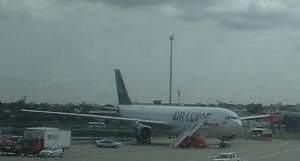 Airbus A330 Luxor Airways at Sydney
Airbus A330 Luxor Airways at Sydney
|
advanced, spacious and efficient airliner ever conceived, and the solution to growing traffic between major hubs. The idea is the A380 superjumbo will provide 15 to 20 per cent lower operating costs, 10 to 15 per cent more range, lower fuel burn, less noise and lower emissions than the largest aircraft flying today.
Boeing
Boeing 707
After the Air Force agreed to let Boeing build commercial jets based on the
prototype, 367-80, already the basis for the KC-135 military tanker,
airlines began to order the 707, the commercial transport variant of the
Dash 80. The 707 and the KC-135 had many features
in common. Both were visually distinct, with a stinger antenna pointing
forward from the top of their vertical fin.
Airlines wanted the 707 fuselage to be 4 inches wider than the tanker's. Its
width and the 100-foot length made it the largest passenger cabin in the
air. Placement of its more than 100 windows allowed airlines to rearrange
seats. Location of passenger doors on the left side, at the front and at the
rear of the cabin, became standard for subsequent Boeing jets. The exteriors
of the 707 and its competitor, the DC-8, were almost
identical, but the 707 wing had more sweepback, so it could fly about 20 mph
faster.
To get its market share, Boeing custom-designed 707 variants for different
customers; examples include making special long-range models for Qantas
Airways of Australia and installing larger engines for Braniff's
high-altitude South American routes. Costs of such customizing were high, so
with every version of the 707, the financial risk increased. After much
effort, sales of the 707 picked up. The risk-taking paid off, and the 707
outpaced the DC-8 in sales.
Although the 707s were intended as medium-range transports, they were soon
flying across the Atlantic Ocean and across the continent. Boeing delivered
855 Model 707s in all versions between 1957 and 1992; of these, 725,
delivered between 1957 and 1978, were for commercial use.
The 707 was designated the 720B when it was modified for short-to-medium
routes and for use on shorter runways. Engineers reduced the fuselage length
by 9 feet, changed the leading-edge flaps and later installed turbofan
engines. Boeing built 154 720s between 1959 and 1967. Its
short-to-medium-range role was later filled by 727s and 737s.
First flight: Dec. 20, 1957
Model number: 707-120
Classification: Commercial transport
Span: 130 feet 10 inches
Length: 144 feet 6 inches
Gross weight: 248,000 pounds
Cruising speed: 600 mph
Range: 3,000 miles
Ceiling: 41,000 feet
Power: Four 13,500-pound-thrust P&W JT3C-6 turbojet engines
Accommodation: Up to 181 passengers
Boeing 727
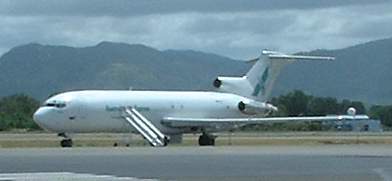 Boeing 727 Australian at Cairns
Boeing 727 Australian at Cairns
|
The 727 was designed to service smaller airports with shorter runways than
those used by the 707s. Of all the early Boeing jets, the 727 had the most
distinctive appearance, with its rakish T-shaped tail and its trio of
rear-mounted engines. It flew to every corner of the world and carried
billions of passengers on everything from short hops to cross-country
flights. Its T-tail allowed it to climb fast, fly fast and descend fast
without unnecessary vibrations.
The 727 was the first Boeing jetliner to undergo rigorous fatigue testing,
the first to have completely powered flight controls, the first to use
triple-slotted flaps and the first to have an auxiliary power unit (APU).
The APU was a small gas turbine engine that eliminated the need for ground
power or starting equipment in the more primitive airports of developing
countries.
The first 727 rolled out Nov. 27, 1962, bearing the same lemon-yellow and
copper-brown color scheme as the Dash 80. However, by the time of its first
flight, orders were still below the estimated break-even point of 200. To
help spur sales, Boeing sent a 727 on a 76,000-mile tour of 26 countries.
Originally, Boeing planned to build 250 of the planes. However, after being
shown to the world, they proved so popular (especially after the larger
727-200 model, which carried up to 189 passengers, was introduced) that a
total of 1,832 were produced at the Renton plant. Variants included a
convertible passenger-cargo model with a Quick Change (QC) option - seats
and galleys attached to removable pallets.
First flight: Feb. 9, 1963
Model number: 727-100
Classification: Commercial transport
Span: 108 feet
Length: 133 feet 2 inches
Gross weight: 170,000 pounds
Top speed: 632 mph
Cruising speed: 570 mph
Range: 3,110 miles
Ceiling: 36,100 feet
Power: Three 14,000-pound-thrust P&W engines
Accommodation: 131 passengers
Boeing 737
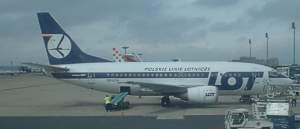 Boeing 737-200 LOT Polish Airlines at LHR
Boeing 737-200 LOT Polish Airlines at LHR
|
The smaller, short-range 737 twinjet was the logical airplane to complement
the 707 and the 727. There was increasing demand for transports in its
category, but the 737 faced heavy competition from the Douglas DC-9
and the BAC-111.
To save production time, and get the plane on the market as soon as
possible, Boeing gave the 737 the same upper-lobe fuselage as the 707 and
727, so the same upper-deck cargo pallets could be used for all three jets.
The 737 later adopted the 727's cargo convertible features, which allowed
the interior to be changed from passenger to cargo use in the 737-200
series.
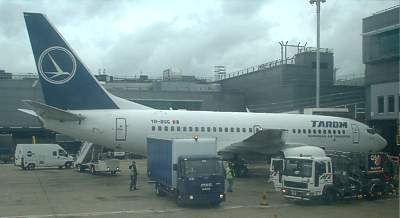 Boeing 737-500 Tarom at LHR
Boeing 737-500 Tarom at LHR
|
The 737 had six-abreast seating - a selling point, because this way it could
take more passengers per load - the DC-9 seated five abreast. The number of
seats in the 737 also was increased by mounting the engines under the wing.
This engine placement buffered some of the noise, decreased vibration and
made it easier to maintain the airplane at ground level. Like the 727, the
737 could operate self-sufficiently at small airports and on remote,
unimproved fields. The plane's performance in these conditions led to orders
in Africa. Later, airlines in Central and South America, Asia and Australia
bought the versatile jet.
At first, the 737 was called the "square" airplane because it was as long as
it was wide. The new technology made the position of flight engineer
redundant; the 737's two-person flight deck became standard among air
carriers. Nineteen 737-200s, modified as T-43 navigator trainers, served
with the Air Force, and the last 737-200 was delivered Aug 8, 1988.
On June 12, 1987, the plane that had to play catch-up did; its orders
surpassed the 727, making it the most-ordered plane in commercial history.
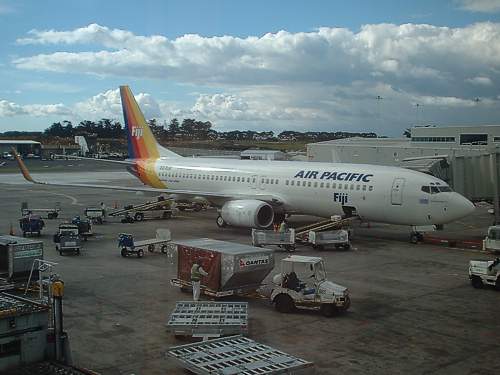 Boeing 737-800 Fiji at Auckland
Boeing 737-800 Fiji at Auckland
|
Not all 737s are the same. The old version is the 737-100/200. From 1991, the only models were
the 737-300, -400 and -500. Now the company makes the -600, -700, -800 and
-900 (Basically, the small, medium, and large. The -700 is the industry standard, seating 149.
Very few airlines fly the -900, the Xl, seating over
200 in a one isle layout. Its not expected to be a best seller).
The 737-700 is exactly the same size as a 737-300, but has better wings, so
flies 10% faster, saving about 20 minutes on a flight from LHR to Athens.
First flight: April 9, 1967
Model number: 737-100/200
Classification: Commercial transport
Span: 93 feet
Length: 93 feet 9 inches
Gross weight: 111,000 pounds
Cruising speed: 580 mph
Range: 1,150 miles
Ceiling: 35,000 feet
Power: Two 14,000-pound-thrust P&W JT8D-7 engines
Accommodation: 2 crew, up to 107 passengers
Boeing 747
During the late 1960s, some 50,000 Boeing people belonged to a group called
"The Incredibles." These were the construction workers, mechanics,
engineers, secretaries and administrators who made aviation history by
building the 747 - the largest civilian airplane in the world - in less than
16 months.
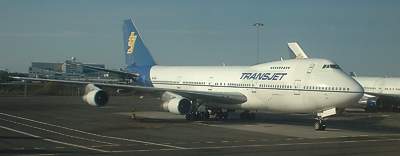 Boeing 747-200 Transjet at Stockholm Arlanda
Boeing 747-200 Transjet at Stockholm Arlanda
|
The incentive for creating the giant 747 came from reductions in air fares,
an explosion in air-passenger traffic and increasingly crowded skies. In
addition, Boeing had already developed the design concepts and technology of
such an airplane because the company had bid on, but lost, the contract for
a gigantic military transport, the C-5A.
The 747's final design was offered in three configurations: all passenger,
all cargo and a convertible passenger/freighter model. The freighter and
convertible models loaded 8- by 8-foot cargo containers through the huge
hinged nose.
The 747 was truly monumental in size. The massive airplane required
construction of the 200-million-cubic-foot 747 assembly plant in Everett,
Wash., the world's largest building (by volume). The fuselage of the
original 747 was 225 feet long; the tail as tall as a six-story building.
Pressurized, it carried a ton of air. The cargo hold had room for 3,400
pieces of baggage and could be unloaded in seven minutes. The total wing
area was larger than a basketball court. Yet, the entire global navigation
system weighed less than a modern laptop computer.
Pilots prepared for the 747 at Boeing training school. The experience of
taxiing such a large plane was acquired in a contraption called "Waddell's
Wagon," named after Jack Waddell, the company's chief test pilot. The pilot
sat in a mockup of the 747 flight deck built atop three-story-high stilts on
a moving truck. The pilot learned how to maneuver from such a height by
directing the truck driver below him by radio.
The National Aeronautics and Space Administration later modified two
747-100s into Shuttle Carrier Aircraft. The next version, the 747-200, holds
approximately 440 passengers and has a range of about 5,600 nautical miles.
In 1990, two 747-200Bs were modified to serve as Air Force One
and replaced the VC-137s (707s) that served as the
presidential airplane for nearly 30 years.
 Boeing 747-400 Fiji Air Pacific at LHR
Boeing 747-400 Fiji Air Pacific at LHR
|
The 747-300 has an extended upper deck and carries even more passengers than
the -200. The 747-400 rolled out in 1988. Its wingspan is 212 feet, and it
has 6-foot-high "winglets" on the wing tips. The 747-400 also is produced as
a freighter, as a combination freighter and passenger model, and as a
special domestic version, without the winglets, for shorter-range flights.
First flight: Feb. 9, 1969
Model number: 747-100/-200
Classification: Commercial transport
Span: 195 feet 8 inches
Length: 231 feet 4 inches
Gross weight: 735,000 pounds
Cruising speed: 640 mph
Range: 6,000 miles
Ceiling: 45,000 feet
Power: Four 43,000-pound-thrust P&W JT9D-3 engines
Accommodation: 33 attendants, 374 to 490 passengers
Boeing 757
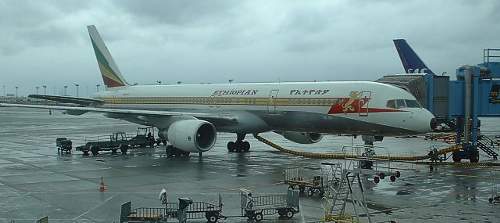 Boeing 757 Ethiopian Airways at Copenhagen
Boeing 757 Ethiopian Airways at Copenhagen
|
The twin-engine, medium-range 757 is up to 80 percent more fuel efficient
than the older 727 jetliners it was designed to replace, but retains the
727's short-field capability. The 757-200 carries up to 228 passengers and
has a range of approximately 3,900 nautical miles.
The 757 and the 767 were developed concurrently, so both shared the same
technological advances in propulsion, aerodynamics, avionics and materials.
Flight decks of the 757 and 767 are nearly identical, so pilots can easily
qualify to fly both.
The first 757 rolled out of the Renton factory in 1982. By 1990, airlines
around the world had ordered more than 600 of them.
On March 29, 1991, a 757, powered by only one of its engines, took off,
circled and landed at the 11,621-foot-high Gongga Airport in Tibet. The
airplane performed perfectly although the airfield was in a box canyon
surrounded by peaks more than 16,400-ft high.
In 1996, the company launched a new version of the 757 twinjet. The new
757-300 seats up to 280 passengers and has about 10 percent lower seat-mile
operating costs than the -200, which has the lowest seat-mile operating cost
in its market segment. The first 757-300 was delivered in1999.
More than 1,000 757s have been delivered since 1982.
First flight: Feb. 19, 1982
Model number: 757-200
Classification: Commercial transport
Span: 124 feet 10 inches
Length: 155 feet 3 inches
Gross weight: 255,000 pounds
Top speed: 609 mph
Cruising speed: 500 mph
Range: 3,200 to 4,500 miles
Ceiling: 42,000 feet
Power: Two 37,000- to 40,100-pound-thrust RB.211 Rolls-Royce or 37,000- to
40,100-pound-thrust 2000 series P&W engines
Accommodation: 200 to 228 passengers
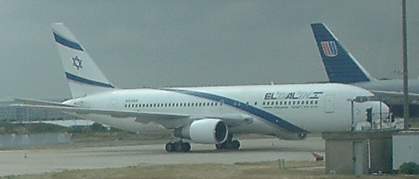 Boeing 767 ElAl at LHR
Boeing 767 ElAl at LHR
|
Boeing 767
The 767, built in Washington alongside the 747, complements the 747 in
the medium- to long-range market and can carry approximately 220 passengers.
The 767 is a wide-body, double- aisle jet, but, like the smaller
standard-body 757, is designed for fuel efficiency. Both planes have nearly
identical digital cockpits, allowing crews to be easily qualified on both.
The extended-range version 767-300 covers distances of more than 6,000
nautical miles.
In December 1991, Boeing offered a modified 767 commercial jetliner as the
platform for its Airborne Warning and Control System (AWACS),
previously carried aboard the 707. In January 1993, Boeing
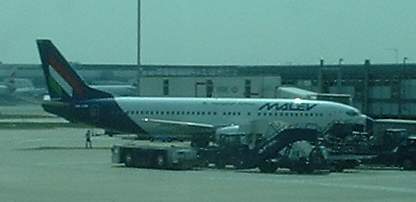 Boeing 737 Malev at LHR
Boeing 737 Malev at LHR
|
started to build the 767 Freighter, an all-cargo version of the 767-300,
which rolled out in May 1995 and was first delivered in October 1995.
In January 1997, the company announced a new extended-range version of the
767.
The new 767-400ER entered commercial service in 2000 and is capable of carrying more than 300 passenger in a two-class configuration.
First flight: Sept. 26, 1981
Model number: 767-200
Classification: Commercial transport
Span: 156 feet 1 inches
Length: 159 feet 2 inches
Gross weight: 300,000 pounds
Cruising speed: 550 mph
Range: 3,840 to 7,800 miles
Ceiling: 43,199 feet
Power: Two 48,000- or 50,000-pound-thrust P&W JT9D-R4D or
57,900-pound-thrust GE CF6-80A2 engines
Accommodation: 216 to 290 passengers
Boeing 777
The Model 777, the first entirely new Boeing airplane in more than a decade,
was delivered in May 1995. Market demand sized, shaped and launched the 777,
created to be the most preferred airliner in the medium-sized aircraft
category. As the world's largest twinjet, it carries 305 to 440 people and
has a range of 4,560 miles, and all 777 versions fly higher than their
Airbus equivalents. Airlines could use two levels of engine thrust,
according to their needs, and the 777 engines were made by three different
companies. By the end of 1997, 364 of the 777s had been ordered by more than
20 airlines.
The increased-gross-weight, longer-range 777, called the 777-200IGW, capable
of flying the same number of passengers as the -200 up to 8,320 miles, was
first delivered in February 1997. Delivery of the first 777-300, a stretched
version, was set for spring 1998.
The 777 is the widest, most spacious airplane in its class and includes
improvements in airfoil technology, flight deck design, passenger comfort
and interior flexibility. Its greater payload and range capability result in
lower operating costs to airlines and its standard equipment includes many
features that are optional on other airliners.
First flight: June 12, 1994
Model number: 777-200
Classification: Commercial transport
Span: 199 feet 11 inches
Length: 209 feet 1 inch
Gross weight: 506,000 pounds
Cruising speed: 615 mph
Range: 4,210 to 8,270 miles
Ceiling: 37,900 feet
Power: Two 74,500-/77,200-pound-thrust P&W 4074/4077 engines, two
74,500-/76,400-pound-thrust GE90-75B/76B engines, or two
74,600-/76,900-pound-thrust RR Trent 875/877 engines
Accommodation: 305 to 440 passengers

 Airbus A320 Tunisair at London Heathrow
Airbus A320 Tunisair at London Heathrow develop a family of aircraft sharing the same cockpit and the same flight
handling characteristics. Airbus Industrie's experience in composite
materials led to the introduction of an all-carbon fiber tail on the A320 --
which has been followed by Airbus Industrie on all subsequent aircraft.
develop a family of aircraft sharing the same cockpit and the same flight
handling characteristics. Airbus Industrie's experience in composite
materials led to the introduction of an all-carbon fiber tail on the A320 --
which has been followed by Airbus Industrie on all subsequent aircraft.
 Airbus A340s LanChillie at Auckland
Airbus A340s LanChillie at Auckland Airbus A340s Jamacian and Virgin at LHR
Airbus A340s Jamacian and Virgin at LHR Airbus A340 China Eastern Airlines at Auckland
Airbus A340 China Eastern Airlines at Auckland Airbus A340 British West Indies Airlines LHR
Airbus A340 British West Indies Airlines LHR Airbus A310 Yemen Airways at LHR
Airbus A310 Yemen Airways at LHR Airbus A330 Luxor Airways at Sydney
Airbus A330 Luxor Airways at Sydney Boeing 727 Australian at Cairns
Boeing 727 Australian at Cairns Boeing 737-200 LOT Polish Airlines at LHR
Boeing 737-200 LOT Polish Airlines at LHR Boeing 737-500 Tarom at LHR
Boeing 737-500 Tarom at LHR Boeing 737-800 Fiji at Auckland
Boeing 737-800 Fiji at Auckland Boeing 747-200 Transjet at Stockholm Arlanda
Boeing 747-200 Transjet at Stockholm Arlanda Boeing 747-400 Fiji Air Pacific at LHR
Boeing 747-400 Fiji Air Pacific at LHR Boeing 757 Ethiopian Airways at Copenhagen
Boeing 757 Ethiopian Airways at Copenhagen Boeing 767 ElAl at LHR
Boeing 767 ElAl at LHR Boeing 737 Malev at LHR
Boeing 737 Malev at LHR